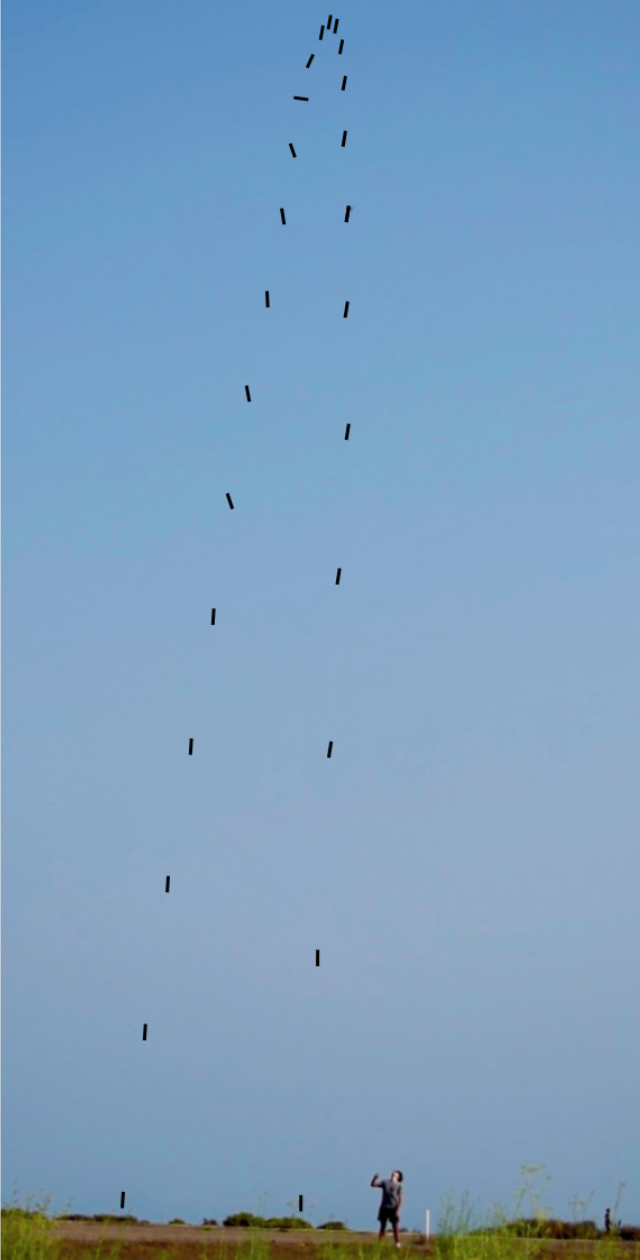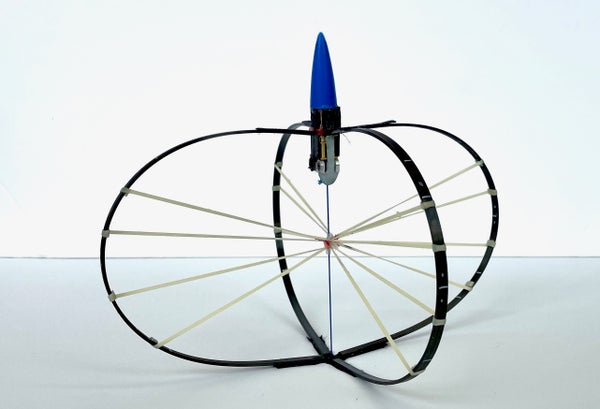When engineers want to design robots capable of navigating complex real-world environments, they often turn to the animal kingdom. Such biomimicry has produced bots that run like dogs or cheetahs or hop like birds taking off in flight. But now researchers at the University of California, Santa Barbara, have reached new heights by ignoring the constraints of biological models. Their 30-centimeter-tall jumper can spring more than 30 meters into the air—roughly the elevation of a 10-story building and 100 times its own height.
This gravity-defying performance is several heads and shoulders above the distance any living creature can reach. “The best animal jumper is likely [a squirrel-sized primate called] the galago, which has been measured jumping around 2.3 meters high from a standstill,” says Elliot W. Hawkes, a mechanical engineer at U.C. Santa Barbara and lead author of a study detailing the superjumper project. He adds that the device also stands out in the mechanical field, where combustion has previously launched jumpers to heights of eight meters and compressed gas has driven them to reach 10 meters. “It jumps much higher than most of the rest of the jumping robots in the world do—if not all of them that I’m aware of,” says Sarah Bergbreiter, a mechanical engineer at Carnegie Mellon University, who was not involved in the new study but wrote an accompanying commentary about it.

Image of the device jumping, with lines added over the position of the jumper approximately every 200 milliseconds. The human is 1.83 meters tall. Credit: Brian Long/Amy Hao/Chris Keeley/Elliot Hawkes
On supporting science journalism
If you're enjoying this article, consider supporting our award-winning journalism by subscribing. By purchasing a subscription you are helping to ensure the future of impactful stories about the discoveries and ideas shaping our world today.
The team designing the new leaper relied on elastic power. In this kind of jumping system, a part called an actuator moves and stores energy in a spring, which is released by a latch to propel an object into the air. This basic mechanism is similar to the one members of the animal kingdom use. For example, a grasshopper’s leg muscle serves as an actuator: when it contracts, it bends back a springlike part of its knee joint to create tension, which is released to propel the insect’s jumps.
But for the new project, human engineering introduced some crucial innovations. For any elastic-based jumper, attainable height is determined by the amount of energy the spring can store—and this, in turn, depends on two factors. The first is how much work an actuator can provide. In animals, muscles have only one contraction with which they can stretch their “spring.” But for the actuator in the new mechanical jumper, the engineers used a motor—which could turn multiple times before each jump and thus keep storing more energy.
The second factor in an elastic jumper’s prowess is the spring’s ability to hold as much energy as possible without packing on too much extra weight. To maximize the new bot’s energy density, the team created a 30-gram device whose whole body acts as the spring. It consists of rubber bands and carbon fiber slats, which have a much higher energy density than biological tissues. When the actuator (a light rotary motor) turns, it winds up a string that constricts the spring: it puts the rubber bands under tension and compresses the carbon fiber, bending each slat into a curved configuration like an archer’s bow. Then the latch releases, shooting the bot into the air at about 100 kilometers per hour—a little like a self-propelled arrow. The team described it in a Nature paper published on Wednesday.
A robot that can hurl itself over buildings could efficiently navigate some common environments that currently hinder wheeled, walking or even flying designs. “Jumping, in some sense, is a wonderful way of getting around because you can jump over obstacles that might be in your path,” Bergbreiter notes, “whereas you don’t have a lot of the complexity that comes from trying to fly over those obstacles or navigate around those obstacles with legs.” Hawkes is especially eager to develop jumping bots for space exploration; he points out that his device could soar to even more impressive distances in an airless, low-gravity environment. “On the moon, our device could theoretically jump forward half of a kilometer while going 125 meters high in a single leap,” he says. “For instance, it could hop onto the side of an inaccessible cliff or leap into the bottom of a crater, take samples and return to a wheeled rover.”
Hawkes is working with NASA to further develop the device. But before it shoots for the moon, the jumper will have to undergo more development. The current prototype has no ability to navigate autonomously, for instance. It also relies on a battery to power its motor and takes a couple of minutes to reload its spring between each jump. And importantly, it cannot control the height of its leap. Still, Hawkes hopes to have a more sophisticated version ready for takeoff in five years.
Even without leaving the planet, however, the new device can help scientists by demonstrating the limits of biomimicry. Many jumping robots are designed, in part, to help researchers study how beings from fleas to humans hurl their bodies into the air. As a result, they incorporate the limitations of those animals—but this project helps show that they do not have to and that ignoring certain rules comes with big advantages. “Biological systems work under different constraints than engineered systems, meaning that an ideal solution in biology is not always ideal in engineering,” Hawkes explains. “It is imperative to consider how a given engineered system has similar and different constraints than a model biological system—and design accordingly rather than simply copying a solution found in nature.” The success of this approach suggests it could be adapted to build other agile machines for a variety of applications.
Bergbreiter agrees. “We do not have to engineer systems with the same limitations that biology has—in the same way that planes don’t flap and cars don’t run,” she says. “We can engineer systems very differently because we have different assumptions and limitations going in.”
